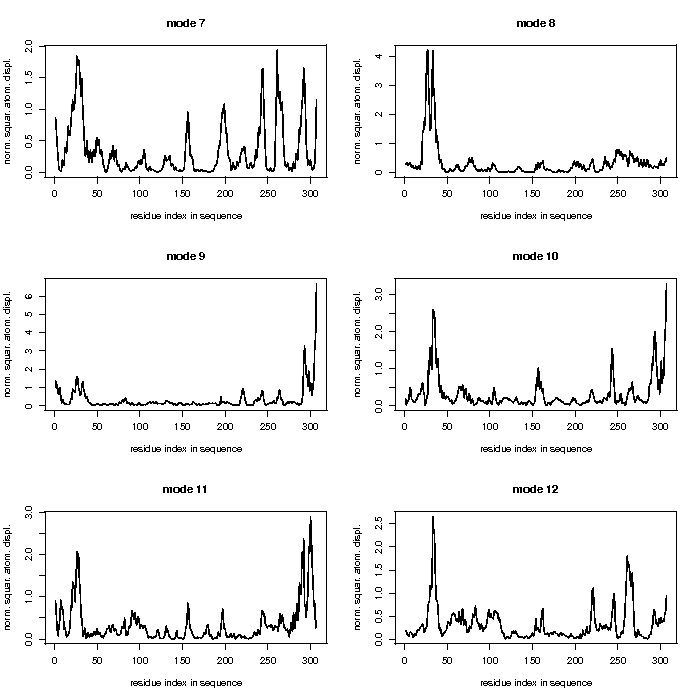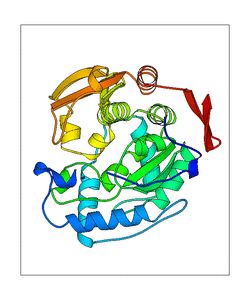Difference between revisions of "Normal mode analysis (Phenylketonuria)"
(→elNémo) |
(→Mode 7) |
||
| Line 13: | Line 13: | ||
<br clear=all> |
<br clear=all> |
||
==== Mode 7 ==== |
==== Mode 7 ==== |
||
| − | <figure id="web_mode7"><small>[[File:PAH_1j8u_mode7.png|thumb|left|300px|'''<caption>'''Mode 7 captured of WEBnm@. |
+ | <figure id="web_mode7"><small>[[File:PAH_1j8u_mode7.png|thumb|left|300px|'''<caption>'''Mode 7 captured of WEBnm@. The PAH structure (pdb 1j8u) is shown in transperent green, the ligands in red (H4B: C<sub>9</sub>H<sub>15</sub>N<sub>5</sub>O<sub>3</sub>) and orange (Fe<sub>2</sub>). The blue doted lines represent the movement of the structure. </caption>]]</small></figure> |
This mode seems to have a high movement as the blue doted lines in <xr id="web_mode7"/> are relatively long. Furthermore they seem to open and close on all sites the same, which gives the imagine of a pump and not a twist. This also can be viewed in the first picture to the top left of <xr id="webMode"/>. Between residues 20 and 30 there is a high atomic displacement which also can be seen for residues 240 to 300. |
This mode seems to have a high movement as the blue doted lines in <xr id="web_mode7"/> are relatively long. Furthermore they seem to open and close on all sites the same, which gives the imagine of a pump and not a twist. This also can be viewed in the first picture to the top left of <xr id="webMode"/>. Between residues 20 and 30 there is a high atomic displacement which also can be seen for residues 240 to 300. |
||
<br clear=all> |
<br clear=all> |
||
| + | |||
==== Mode 8 ==== |
==== Mode 8 ==== |
||
<figure id="web_mode8"><small>[[File:PAH_1j8u_mode8.png|thumb|left|300px|'''<caption>'''Mode 8 captured of WEBnm@. PDB structure is shown in transperent green, the ligands in red (H4B) and orange (Fe2). The blue doted lines represent the movement of the structure. </caption>]]</small></figure> |
<figure id="web_mode8"><small>[[File:PAH_1j8u_mode8.png|thumb|left|300px|'''<caption>'''Mode 8 captured of WEBnm@. PDB structure is shown in transperent green, the ligands in red (H4B) and orange (Fe2). The blue doted lines represent the movement of the structure. </caption>]]</small></figure> |
||
Revision as of 12:31, 30 July 2013
Page still under construction!!!
Contents
Summary
...
Normal Mode Analysis
Lab journal
For the analysis, we used the pdb structure 1J8U from the task before (Task 9 - Structure-based mutation analysis).
WEBnm@
<figure id="webMode">
</figure>
Mode 7
<figure id="web_mode7">
</figure>
This mode seems to have a high movement as the blue doted lines in <xr id="web_mode7"/> are relatively long. Furthermore they seem to open and close on all sites the same, which gives the imagine of a pump and not a twist. This also can be viewed in the first picture to the top left of <xr id="webMode"/>. Between residues 20 and 30 there is a high atomic displacement which also can be seen for residues 240 to 300.
Mode 8
<figure id="web_mode8">
</figure>
Mode 8 of WEBnm@ show a few differences to mode 7 as there seems only be a atomic displacement at residues 20 to 50 (<xr id="webMode"/> top right). In <xr id="web_mode8"/> you can see that this is represented in the picture on the right site of the binding site. Maybe this helps the protein to bind or release a substrate.
Mode 9
<figure id="web_mode9">
</figure>
Like in the mode before there is only a part of the protein which shows a high atomic displacement, which can be found at the residues 280 to 310 (<xr id="webMode"/>). ...
Mode 10
<figure id="web_mode10">
</figure>
Mode 10 shows a high atomic displacement in some parts of the protein. Especially in the beginning before residue 50 and again after residue 280 (<xr id="webMode"/>). However, in <xr id="web_mode10"/> there seems to be not that high movements. ...
Mode 11
<figure id="web_mode11">
</figure>
This mode seems to have some similarities with mode 10 before in the atomic displacement as there is a high atomic displacement in the beginning and in the end of the protein ((<xr id="webMode"/>, bottom left). However, looking at <xr id="web_mode11"/> some differences can be viewed like in the bottom left of the picture, where you can see that the movement has another direction.
Mode 12
<figure id="web_mode12">
</figure>
The last mode provided by WEBnm@ here shows highest atomic displacement at residues 25 to 50 (<xr id="webMode"/>, bottom right). In <xr id="web_mode12"/> you can see ...
<figure id="correlation">
</figure>
elNémo
ElNémo computes models for the given protein 1J8U. Thereby it calculates 100 lowest-frequency modes and provides a lot of information about the modes with different parameters and visualizations:
- PDB-files with the conformations of the modes
- animations of the modes of three different sites
- CA-vari (calculates distance fluctuations between all C-alpha atoms)
- R2 residue mean square displacement of all C-alpha atoms
- Frequency and collectivity of the modes
<figtable id="frecol">
| First five modes | |||
|---|---|---|---|
| Mode | Frequency | Collectivity | |
| mode 7 | 1.00 | 0.5475 | |
| mode 8 | 1.02 | 0.4062 | |
| mode 9 | 1.36 | 0.2941 | |
| mode 10 | 1.43 | 0.0948 | |
| mode 11 | 1.60 | 0.3466 | |
</figtable>
- B-factor analysis for the correlation between observed and normal-mode-derived atomi displacement parameters:
- Correlation = 0.534 for 307 C-alpha atoms
- RMSD: only if two structures are used
Theoretical every number of normal mode perturbed models can be generated. However, a high number would take a lot of time. On default five normal modes will be computed by elNémo and can be increased up to 25. Additionally more normal modes can be calculated after the run. The analyses of the five modes with lowest frequency normal modes are shown below. For the calculation of the models all atoms are used.
Mode 7
<figure id="mode7_gif">
</figure>
<figure id="mode7_matrix">
</figure>
Like mode 7 of WEBnm@ this mode of elNémo seems to pump. ...
Mode 8
<figure id="mode8_gif">
</figure> <figure id="mode8_matrix">
</figure>
In <xr id="mode8_gif"> you can see that the protein opens and closes at the binding site, whereby it looks like an opening and closing mouth. Additionally in the correlation matrix (<xr id="mode8_matrix"/>) only small parts of the protein seem to move at all.
Mode 9
<figure id="mode9_gif">
</figure> <figure id="mode9_matrix">
</figure>
...
Mode 10
<figure id="mode10_gif">
</figure> <figure id="mode10_matrix">
</figure>
...
Mode 11
<figure id="mode11_gif">
</figure> <figure id="mode11_matrix">
</figure>
...
VMD
...
References
<references/>

















